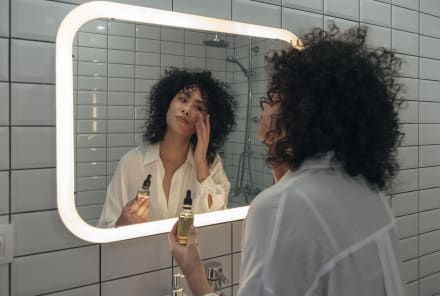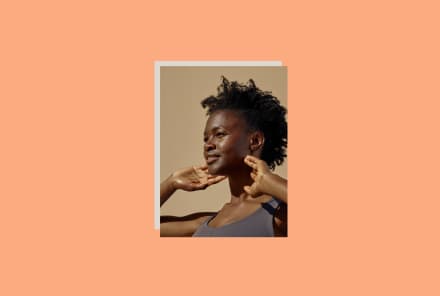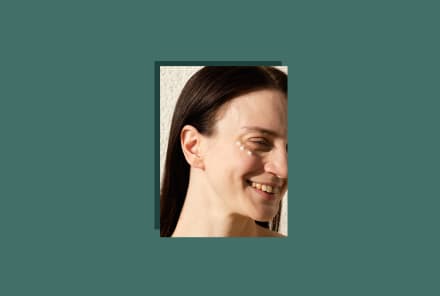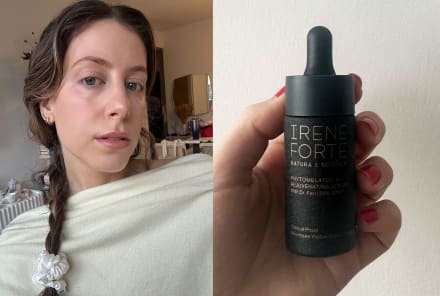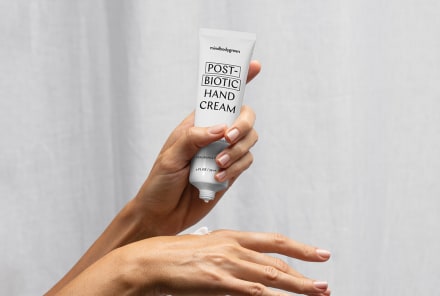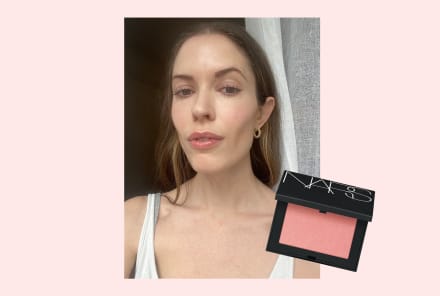Advertisement
Hormonal & Adult Acne: 5 Signs To Look For & Natural Treatments


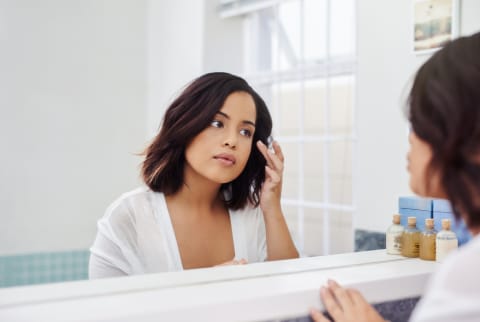
Acne, unfortunately, is not just a teenage issue. While much of the Big Beauty marketing around the issue tends to focus on those tricky youthful years, more and more, we are finding that adult women are dealing with it well into their 20s, 30s, 40s, and even menopause. Yes, women in nearly every age group can wake up to find pesky blemishes spotting their complexion—either as a totally new skin care woe or one you may be used to from the past.
Here, we dive into what adult acne is, what makes it different, how you can tend to it naturally—and why it's very closely related to your hormones.
What is adult & hormonal acne, and how is it different?
We can't discuss adult acne, without explaining acne in general. Acne vulgaris1 is a complex skin condition that occurs from increased sebum production, chronic inflammation, and the normal skin bacteria Propionibacterium acnes. Although P. acnes is a normal organism that lives on your skin (collectively called the microbiome), it causes trouble when it gets trapped under the skin’s surface. When this happens it wreaks havoc by causing increased inflammation, both on the surface of the skin and in the deeper layers. This is when you'll see blackheads, whiteheads, pimples, and cysts start to form.
What causes acne? Now that's a hard question to answer, most derms note. See, there is a genetic link with acne2—meaning, you are more likely to have it if someone in your family did or does—but what actually triggers an individual to develop the condition remain somewhat a mystery: Some people are affected more by diet, others respond to external aggressors like an irritating face product; some breakout from stress, others lifestyle habits are to blame. Given the root causes are varied and not totally clear, there is no correct way to treat acne as a whole, given that each case is highly individualized and likely includes multiple confounding causes. Read: Your most effective acne-tending remedy might be different from another person's. That's OK.
So onto the twenty-something-plus kind: Adult acne is simply a colloquial term used to describe acne when it happens to, well, adults. It is often referred to in the general population to as “hormonal acne,” but all acne is hormone-mediated to some degree.
Adult acne does tends to have different triggers and appearance than acne that happens when you are a teen (more on that in a second). And, yes, it is totally possible3 to not have acne as a teen and then develop the condition later in life, although it is less frequent. All-in-all, the condition is completely normal and common: Reports show that half of all women in their 20s have acne4. And by the time women reach their 30s, a third report still having acne. (Even women over 50 still report having acne at a rate of about 15%.) And while men can have adult acne, it is far more prevalent in women than men.
The prevalence of adult acne in women over men likely has to do with one of the triggers of acne: fluctuating hormones. Women's hormones fluctuate more frequently, and given that hormones affect every aspect of your body, they also affect the skin. Here's a summary from the American Academy of Dermatology of how hormones affect the skin as it relates to acne: Hormones can increase sebum production; they can affect how "sticky" skin cells are, making shedding the cells more difficult and leading to clogged pores; and they can cause increased overall inflammation.
5 signs your acne is hormonal:
There are a few ways to tell if your breakouts might be triggered by hormones:
1. Appearance and area can give clues.
Adult acne tends to look and appear different from breakouts you might get because you worked out in your makeup or because it's humid out. First thing to consider: the location. Hormonal acne appears around the chin area, jawline, and neck (and sure, this is suggested by face mapping, but research even confirms this5). And while all acne is triggered by inflammation on some level, hormonal acne tends to show signs of that inflammation more aggressively: meaning it's usually red, tender, and puffy.
2. If it's timed around your period.
Do you tend to break out around your period? This is an incredibly common, and research-backed6, phenomenon: According to a survey, almost two-thirds of acne-prone women report having flares before or on their menses7 (more specifically in the "late luteal phase of the menstrual cycle," or after ovulation and right before you start bleeding). And while the exact mechanism of this is not confirmed, the most general understanding8 tends to be the increased presence of the hormone androgens, specifically DHEA-S, which stimulates the sebaceous glands to produce excess sebum.
3. If it comes from stress.
We know that hormones can be affected by internal and external factors: Research shows9 that stress changes the levels of the corticotropin-releasing hormone both in the blood and in the sebaceous gland itself, which doubly affects sebum production. In other words: Stress can cause more sebum production which can help create an ideal environment for bacteria to flourish on the skin. We also know from research10 that stress causes more inflammation in the body, including skin. The combination of these factors11 can cause hormone-related breakouts during times of stress.
Board-certified dermatologist Jaimie Glick, M.D. agrees that together these form a one-two punch: Overactive sebum production means excess oil traps dead skin cells in our pores. This becomes an ideal environment for the rapid multiplication of the common bacteria that live on our skin. The result is pores that are very inflamed and can quickly become painful pimples. And to top it all off, your body may be less able to deal with existing acne and scarring when you're really stressed. "[One study on stress and wound healing12] has shown that stress can slow down healing, which may worsen acne and acne scarring," says Glick.
If it's diet-related.
Adult acne can also be exacerbated by what you eat. For a few decades, dermatologists denied the connection between food and acne. Well, recent research has started turning the tide on this. Studies show13 that there's a connection between dairy—skim milk, primarily—and acne. Other studies show a strong connection between foods with a high glycemic index and acne symptoms14. While the mechanisms for both of these food groups are different, the speculation is that the breakouts are caused by hormone responses.
Foods with a high glycemic index, notably, have a good amount of research to back them. Overconsumption of foods with a high glycemic load is also a main characteristic of a Western diet and is a key factor in acne development or severity15," says Molly Knudsen, M.S., RDN. "Blood glucose and insulin could affect the skin14 in a couple of different ways: First, this spike in blood sugar causes the release of insulin and insulin-like growth factor-1 (IGF-1). Insulin then stimulates the production of androgens (male hormones) that can then lead to higher sebum production in the skin, and then lead to acne. Secondly, high amounts of insulin in the blood before or after a meal may make the skin create more skin cells, making acne that's already present worse."
If you're in menopause.
Did you think you were out of the acne woods once you started going through menopause? Not so fast. While most skin care changes during this time have to do with increased dryness, collagen loss, and increased sensitivity, menopausal acne is certainly something that can happen. (I hear the collective ugh.)
Menopausal acne has more to do with the changes in the microbiome, since acne is highly influenced by changes in the makeup of your skin flora. "As our hormones diminish in menopause, the functions they perform to maintain the health and vitality of the skin diminish as well, characterized by a change in sweat, sebum, and the immune functions resulting in significant alterations in the skin surface including pH, lipid composition, and sebum secretion," board-certified dermatologist Keira Barr, M.D., previously told us about menopause and skin. "These changes also provide potential alterations in the skin that may affect the skin microbiome."
How can you treat it naturally?
So you've developed acne late in life. Now that you're here (welcome to the club, by the way), there are plenty of ways to tend to your adult skin so you can clear up those blemishes STAT, and keep them away.
Visit a professional.
First, consult with a professional about your acne treatments. (Although acne is non-life-threatening, the presence can affect a person's well-being. Studies show16 that those with acne experience anxiety and depression. And on a more superficial level, untreated acne and picking can lead to permanent scarring.) For more severe cases, they might recommend prescription topicals or oral medications, such as Accutane, spironolactone, or birth control, if you feel comfortable taking these. You can also visit a hormone specialist, if you think your acne warrants it.
Use smart topicals.
At home, there are several tried-and-true ingredients to give a go based on your needs and tolerance. Retinoids (and their natural alternatives) increase cell turnover, making it more difficult for the cells to stick together and clog pores. It's so potent, it's often hailed as the "gold standard" of skin care. After it interacts with the skin's receptors, it beneficially alters the genes involved with inflammation and cell growth: This reduces the formation of microcomedones17, or skin pores clogged with sebum, bacteria, and dead skin cells. (Microcomedones are the precursors to all pimples, so stopping them can make a huge difference.) Retinol also exfoliates within the pores, "where slowed dead cell shedding leads to enlarged pore appearance and breakouts," says board-certified dermatologist Loretta Ciraldo, M.D., FAAD.
After a pimple has come and gone, retinol can help decrease post-breakout scarring as well. In addition to exfoliating dead skin cells, retinoid blocks the activity of enzymes18 behind melanin synthesis, resulting in a more even skin tone.
Salicylic acids are oil-soluble and can help break down and control oil production. AHAs, like lactic and glycolic, are chemical exfoliators that can help unclog pores, but tend to be less drying for sensitive skin folk. And there are plenty of botanical ingredients that help temper inflammation, namely antioxidants.
Here are our favorite moisturizers for acne.
Make skin care tweaks based on your cycle.
Given many people's adult acne comes around when they get their period, you may consider making skin care adjustments around your cycle. This way you're not using potent products daily, and deploy them only when you know zits might be coming. So when should you get prepared? Start around the second week of your cycle.
"On Day 14 there is a surge in luteinizing hormone (LH), which not only harkens a rise in progesterone, but testosterone peaks at Day 14, and these two hormones both contribute to increased sebaceous gland activity and oilier skin including an oily scalp and greasy hair," says Barr. "As estrogen levels are declining, there may be more inflammation, irritation, and disruption of the skin barrier and microbiome, which can also contribute to breakouts."
Don't go overboard—especially if you are in menopause.
One of the most common mistakes people make when they treat adult acne is they assume they can fight it like they did as teens. You can't and shouldn't. Your skin changes as you age, and with these changes come new needs: namely your skin is likely thinner, drier, and more sensitive. Thus, you really need to make sure you're not overloading your skin with harsh, stripping products.
"If you're breaking out, you may not be able to tolerate the treatments you used as a teenager because the skin is thinner and drier and the treatments may be too harsh," says Barr. Instead, focus on supporting your skin barrier function (through things like peptides and ceramides), reducing inflammation in the skin, and keeping sebum production balanced.
Make lifestyle adjustments.
Given everything we've learned about acne's hormonal triggers, you should also treat acne holistically. Consider whether food and stress are triggers. You can try putting yourself on a clear-skin eating plan, or at least limit dairy and foods with a high-glycemic-index rating. As for stress, we know that lowering levels of stress can be good for multiple factors—but we also know it's hard to do, so the best advice here is to try multiple modalities until you find one that is right for you.
The takeaway.
Adult acne, sigh. You think you're in the clear once you've made it out of your teens only to deal with blemishes well into your 20s, 30s, 40s, and beyond. If this is you, don't worry: There are are plenty of ways to remedy your breakouts.
18 Sources
- https://www.ncbi.nlm.nih.gov/pubmed/21880356
- https://www.ncbi.nlm.nih.gov/pmc/articles/PMC5300732/
- https://www.ncbi.nlm.nih.gov/pubmed/22171979/
- https://www.ncbi.nlm.nih.gov/pubmed/17945383/
- https://www.ncbi.nlm.nih.gov/pubmed/20619486/
- https://www.ncbi.nlm.nih.gov/pubmed/15096370/
- https://www.ncbi.nlm.nih.gov/pmc/articles/PMC4142818/
- https://www.ncbi.nlm.nih.gov/pubmed/17988341/
- https://www.ncbi.nlm.nih.gov/pubmed/19077080
- https://www.ncbi.nlm.nih.gov/pmc/articles/PMC5476783/
- https://www.ncbi.nlm.nih.gov/pubmed/1831118
- https://www.ncbi.nlm.nih.gov/pmc/articles/PMC2792763/
- https://www.ncbi.nlm.nih.gov/pmc/articles/PMC6115795/
- https://www.ncbi.nlm.nih.gov/pmc/articles/PMC3257617/
- https://www.tandfonline.com/doi/pdf/10.4161/derm.19828?needAccess=true
- https://www.ncbi.nlm.nih.gov/pubmed/11873431
- https://www.ncbi.nlm.nih.gov/pmc/articles/PMC5574737/
- https://jddonline.com/articles/dermatology/S1545961611P0483X
Watch Next
Enjoy some of our favorite clips from classes
Enjoy some of our favorite clips from classes
What Is Meditation?
Mindfulness/Spirituality | Light Watkins
Box Breathing
Mindfulness/Spirituality | Gwen Dittmar
What Breathwork Can Address
Mindfulness/Spirituality | Gwen Dittmar
The 8 Limbs of Yoga - What is Asana?
Yoga | Caley Alyssa
Two Standing Postures to Open Up Tight Hips
Yoga | Caley Alyssa
How Plants Can Optimize Athletic Performance
Nutrition | Rich Roll
What to Eat Before a Workout
Nutrition | Rich Roll
How Ayurveda Helps Us Navigate Modern Life
Nutrition | Sahara Rose
Messages About Love & Relationships
Love & Relationships | Esther Perel
Love Languages
Love & Relationships | Esther Perel
